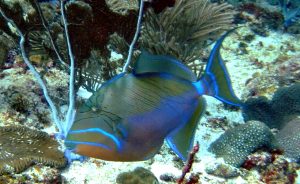Specific Name: Balistes Vetula
Genus: Balistes
Species: Vetula
Family: Balistidae
This beautiful Queen Triggerfish can be described to be a large oval shape that is laterally compressed. The eyes are located towards the top of its head. Their eyes have the ability to move independently of each other. They are about 8-16 inches long. The name ‘triggerfish” comes from the two spines on the anterior dorsal fins that lock the fish into crevices at night. The Queen Triggerfish uses the first fin to lock itself into the crevice and the second fin to unlock itself. This is a defensive mechanism to keep themselves from getting eaten by their predators. This isn’t the only way they protect themselves; these amazing fish can also produce a throbbing sound by using a specialized membrane located beneath their pectoral fin. This throbbing sound is a warning to their predators to stay away.
Coloration:
The back of the Queen Triggerfish is typically green or blue while its abdomen and the lower head are orange and yellow. One of the prettiest features of this fish is the bright blue bands that extend from the snout to the front and below the pectoral fins, the bands around its mouth, and the bands around the caudal peduncle and median fins. Both female and male have similar morphology. The difference in coloration differs in juveniles because the younger triggerfish are paler in color and have smaller fins.
Where can I find them?
The Queen Triggerfish can be found in depths of approximately 7-902 feet, typically over rocky bottoms and around reefs. They also form schools. Geographically they are located in the Caribbean, Bahamas, Florida, Bermuda and the Gulf of Mexico.
What’s for dinner?
The Queen Triggerfish are primarily carnivores but are also sometimes herbivorous as they occasionally eat algae. The majority of their diet consists of sea urchins, bivalves, crabs, starfish, sea cucumbers, shrimp and polychaetes.


